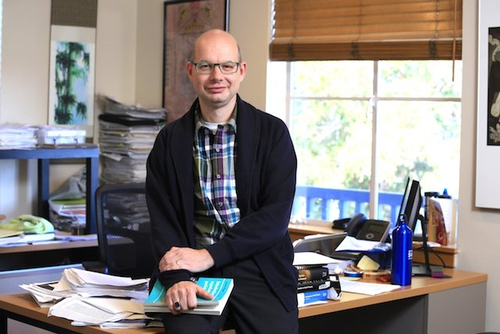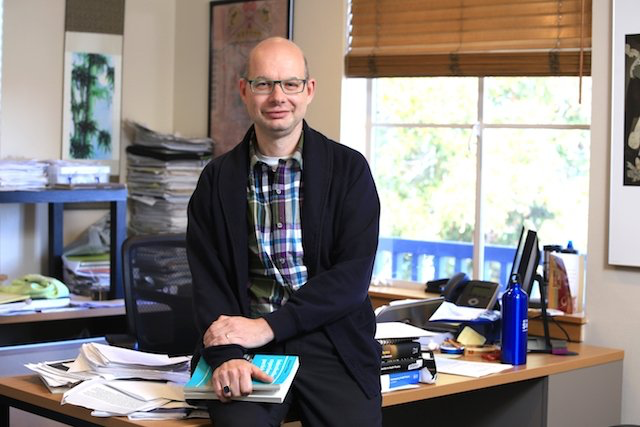Q&A: A Physicist Dressed as a Policy Wonk
Ferenc Dalnoki-Veress has been caught between cultures his entire life. A Dutch citizen of Hungarian descent, he obtained his higher degrees in Canada and took jobs in Italy, Germany, and the U.S. Now Dalnoki-Veress lives in California, where he works as a physicist—among policy wonks—at the James Martin Center for Nonproliferation Studies in Monterey. At the center, experts work to prevent the spread of nuclear weapons by training future policy developers and providing government officials with the information and analysis they need to make informed decisions. His colleagues develop policy recommendations for reducing nuclear arsenals, and Dalnoki-Veress, their so-called “scientist-in-residence,” serves up the physics they need. He also teaches physics to policy students to help them communicate with scientists. In an interview with Physics, he explains how he got into this field and how the tools of particle physics can help rid the world of deadly nuclear materials.
–Sophia Chen
How did you get into nuclear nonproliferation?
I studied experimental high-energy physics as a graduate student and postdoc, but I’ve always been interested in politics—I minored in the subject as an undergrad, and I closely follow international political issues.
I began transitioning to policy when I moved to Princeton University in 2006. My research focus was analyzing background noise in solar neutrino data. But I also audited a course on global security taught by Frank von Hippel, a physicist for whom I have great respect. I then worked with him to develop a simulation that estimates the amount of uranium in a reactor core via its emitted particles. These simulations can verify that no uranium has been surreptitiously removed. That’s when I realized that my physics skills could be applied to real-world nuclear problems.
Another event that motivated my career switch was the Iraq War. The U.S. government had difficulty verifying weapons of mass destruction but took military action anyway. I realized that sometimes politics trumps science, and I wanted to help change that.
What’s it like being a physicist working with policy experts?
I’m in awe of my colleagues—they really know their stuff. But physicists and policy experts approach problems from very different perspectives. It’s like we speak different languages. For example, physicists won’t say they’re absolutely certain about anything, even if its chance of happening is 99.99%. Policy people can misinterpret this apparent lack of certainty as hesitancy and allow too much room for dissenting views that aren’t fact based.
To prevent such a situation, I teach my policy students how physicists think. I also learn from them how they solve problems. Developing policy is enormously complicated—it’s challenging to write an effective treaty that different countries, with their wide-ranging needs, can agree to. Ultimately, I’ve learned that you need to know how to navigate human behavior to design an effective policy.
Can you describe your typical day?
Every day is different—that’s one thing I love about my job. I spend a lot of time trying to uncover potential security threats of emerging technologies. Technology can benefit people’s lives, but it can also be used to harm. For example, a 3D printer is a wonderful tool for spurring innovation in engineering and design. But in the wrong hands, it can potentially also be used to print bomb components or to make equipment for enriching uranium. My work involves planning for such possibilities, by giving policy experts the physics background they need to evaluate worst-case scenarios.
Nuclear nonproliferation can be a morbid topic, with frightening implications. How do you keep yourself from getting depressed?
You’re right, a lot of my work touches on really dark stuff—I recently read a book on nuclear science that contained the term “megadeath.” It’s an awful word used by military planners in the Cold War and means one million deaths.
My motivation comes from the seriousness of the issues I work on. It’s really important that somebody does this work, so that policymakers make informed decisions. People who work in government don’t have the time, so we do it.
You recently published a paper on antineutrino detectors in a physics journal. Could you explain the findings?
The paper investigated how big an antineutrino detector needed to be to sense a nuclear explosion from a distance of several hundreds of kilometers. Such explosions release huge bursts of these particles, but previous detectors weren’t sensitive enough to identify the bursts from far away. We wondered if future detectors, 50 times larger than current devices, could be made more sensitive if they also picked up the seismic waves produced by the explosion.
We did the math but found we were too optimistic. The calculations show that the detector still needs to be much bigger. If not, it needs to be closer to the explosion, which wouldn’t be possible in a country like North Korea.
Are you planning other experiments related to nuclear nonproliferation?
I’m helping to build a new antineutrino detector located in the UK called AIT WATCHMAN, which is scheduled to come online in the next few years. It’s designed to monitor a nuclear reactor’s material from 25 kilometers away.
To my knowledge, this collaboration is the first time that a policy institute has been part of a neutrino detector collaboration. The technology for studying these otherwise esoteric particles is now good enough to apply to serious international political problems. It turns out neutrinos are useful! That’s just so cool to me.
Sophia Chen is a freelance writer based in Tucson, Arizona.
Know a physicist with a knack for explaining their research to others? Write to physics@aps.org. All interviews are edited for brevity and clarity.





